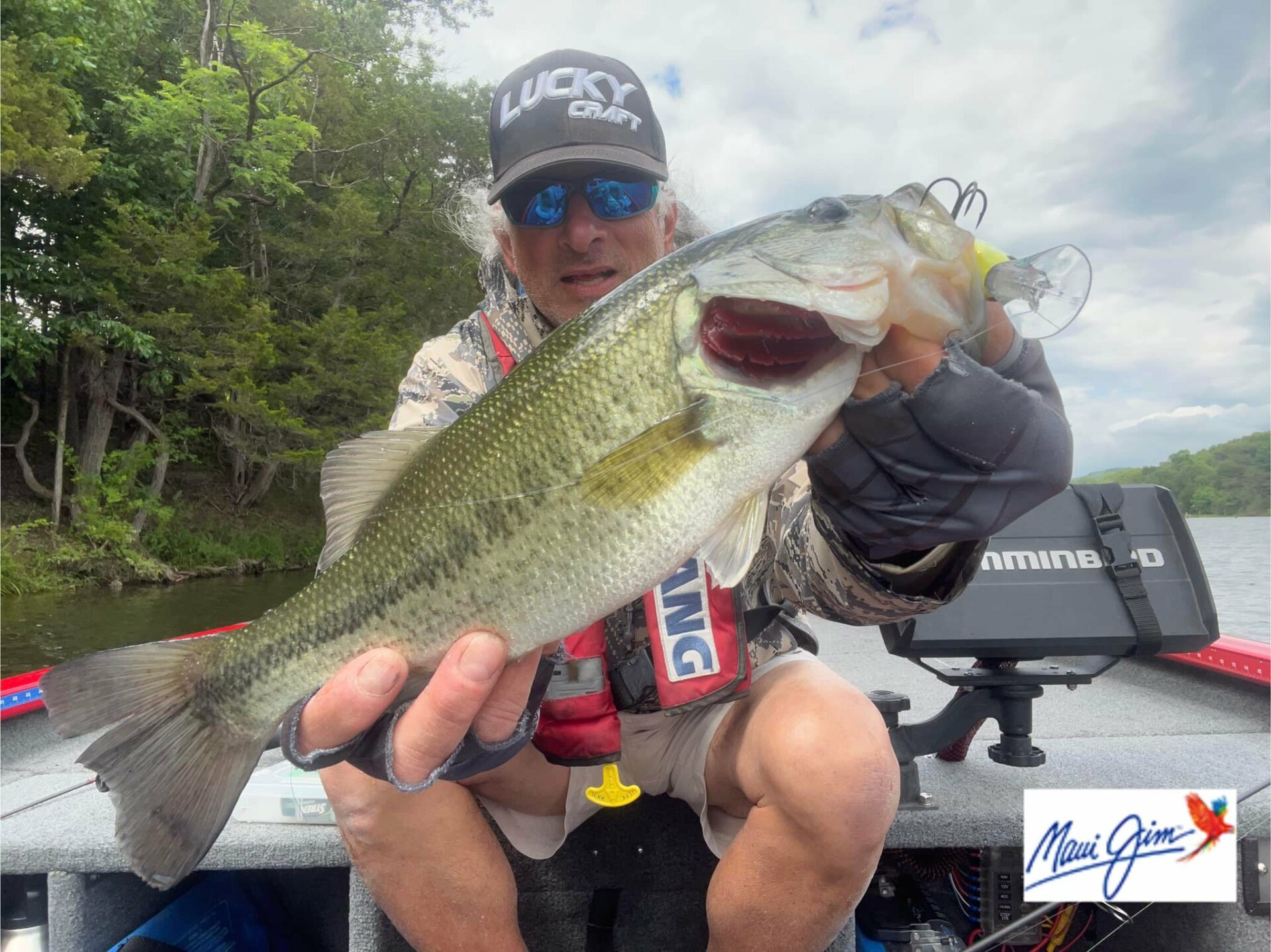There’s nothing more futile in fishing than to be in the back of the boat while the boater stares at a screen while chasing fish in open water. Co-anglers (cos) are left stranded with nearly zero chance of catching fish.
The Forward Facing Sonar (FFS) impact has been realized and now rationalized by the Bassmaster tournament organization. Announcing they’re eliminating cos from their Open tournament trail, they assigned blame to Covid. Co-anglers, blaming FFS, have been dropping out of events post Covid.
Co-angler Lenny Baird has dominated from the back of the boat. It takes special talent to fish behind boaters as they make all decisions on where and how fast to fish. Adjusting to boater decisions has been the co-angler’s challenge but FFS impedes success. Baird has seen technology take over and expected co-angler elimination.
Co-anglers have been essential participants, keeping boaters honest and generating additional tournament revenue. Co-anglers also promoted sponsors, providing companies additional exposure value. Giving cos the opportunity to participate in high level tournaments, with the possibility of moving up to the boater level, increases boat and truck sales.
The co-angler division allowed weekend anglers to travel to various fisheries, learning from anglers from around the country. This model was less costly and required less time off from day jobs than full time pros. Baird will now fish locally, spending less time away from home, fishing out of his boat. Baird says without co-angling, high school and college fishing will be where new anglers gain experience.
Bassmasters diverted attention from FFS negative impacts, blaming Covid for cos leaving, but fans lost interest watching anglers staring at screens.
Another casualty of “video game” fishing is the tackle industry as only a handful of inexpensive tackle is required, thus hurting lure sales. Tournaments are losing promotional effectiveness. Companies are spending less money supporting tournaments and anglers fishing them.
Maryland boater Danny Rodriguez recognizes that it’s recently become a crapshoot for co-anglers because they’re likely to get back-boated by FFS techniques.
“Most boaters probably don’t want to shaft them, but it’s become the nature of the game.” Rodriguez says cos catch some of your fish or make you slow down. He’s helped cos, with three winning from the back of his boat. With co-angler elimination, Rodriquez can now fish his spots at his speed.
Bassmaster’s ruling ignited social media controversy. Many feel the organization is discouraging grass roots anglers. But boaters, encouraged by the cos exit, say they typically put in more time and money for tournaments compared to co-anglers. For co-anglers who feel they’re being excluded from their rightful place, some say they should buy a boat and fish these events.
For boaters and co-anglers, many develop friendships across the country, but acknowledge no other sport requires participants to compete alongside amateurs.
Tournament bass fishing is becoming too expensive to look at a video game while making big monthly payments. Fishing organizations acknowledge the FFS baggage and have restricted its use, however FFS is still the elephant in the boat.
Author Capt. Steve Chaconas is Potomac bass fishing guide & freelance writer. Potomac River reports: nationalbass.com. YouTube video channel NationalBassGuide
FEBRUARY 2025
January water temperatures got down to an icy 40 degrees and things cleared up just fine for February as days get longer and the food chain starts to activate. Fish are where we want them, on drops and edges, keeping them grouped up making for some great winter fishing. Water temperatures hover around 38 and occasionally up to 45. It’s important to pay attention to warm spots…2 degrees can make a HUGE difference. Fishing during the warmest part of the day will be more productive with moving lures. When determining depth and speed…i.e., lure and presentation selection, remember outgoing tides bring warmer water below Blue Plains and incoming tides can lower water temperatures by 5 degrees.
Areas that stay warm: Quantico Creek, Blue Plains and Four Mile Run. Out of the current areas: Spoils, Smoots, Belle Haven, Mount Vernon, Oxen Cove, Washington Channel, Pohick Bay, and the Pentagon Lagoon have deep water.
In Four Mile Run, the point in front of the restaurant is a great place to use Silver Buddy lures and dropshots. Deeper water around the marina is also good. Just up the creek, water temperature can rise to near 60. Riprap and bridge pilings are great places to toss stickworms like Mud Puppy Jiggle Sticks 5-inch worm on Gamma Fluorocarbon. Topwaters aren’t out of the question! I prefer to toss suspending jerkbaits in Baby Bass and other “natural” patterns. Shallow cranks are good. At Blue Plains, work drop shot, split shot, Carolina rigs, with 5-inch Mud Puppy Custom Lures 5’ Brush Monkey soaked in attractant very slowly. Don’t leave without using green/orange hair jigs on 6-pound test Gamma Copoly. When tides fall, the Blue Plains dock is great…under on sunny and around front on cloudy days. The Dominion Possum Point Power Plant pumps out warmed water into Quantico Creek. Fish the entire creek according to temperature.
Fox Ferry fish are grouped on drop-offs, 6-15 feet deep depending on water temperature. On warmer tides, use tight wiggle crankbaits in craw patterns, chartreuse/brown back on 10-pound test. Crank parallel to the Ferry and pause when contacting cover. Same works on riprap around Oxen Cove.
The Spoils has plenty of drops, concrete islands, a jetty, a few wreck remnants, and a ditch rimming outside. Below the bridge Smoot Bay has similar drops and two obvious points, one north and one south. Other less obvious spots seldom fished: Fort Washington Lighthouse Point and Hogg Island. Locate deep water near flats with cover out of current.
The 1/2-ounce size Silver Buddy is my favorite, but 1/4 when the bite is tough. Cast on 10-pound test Gamma EDGE on a casting reel to 3-foot depths and work down drops with very short burps, noting where bites come. Depths depend on water temperature and how long water has been at that temperature. Fish aren’t chasing baits when you get one; you’ve found the day’s winter depth. Sometimes you’ll feel a tick on the drop, set the hook! Other times, you cannot feel anything, except pressure or weight when you move the bait. Don’t overwork! For rods, I really like a medium action graphite. Replace worn Silver Buddy hooks…use split shank trebles, or cut the hook eye, twist open, attach, snap back to close.
The plastics bite is light. Move baits Mud Puppy SR 3-inch avocado (stingray) grubs, 4-inch tubes, 5-inch Mud Puppy Custom Lures DS (drop shot) worms, and 1/4 ounce hair jigs with 6-8 pound test Gamma Copoly very slowly, stopping frequently. Hair jigs are awesome jigs for cold water…compact and the hair breathes, prompting strikes when sitting! Use 1/4-ounce hair jigs in two colors…black/blue, and olive/orange. Light line and either pork or plastic chunks with rattles worked very slowly. Attractants get fish to hold on longer! Hair jigs soak up attractants! “Gel” style attractants make the hair clog up! Keep rod tips lower to set the hook. Not a huge hookset, just reel and lift.
Use a 1/4-ounce round jig heads for Mud Puppy Custom Lures SR (stingray) grubs on spinning gear spooled with 10 pound test Gamma Torque braid with 6 pound test Edge leader. PRO’S Soft Bait Glue keeps grubs in place! Work on bottom slowly, stopping often. Rather than hopping, lift, glide and stop, shake occasionally. Shaky heads work well too! Start with 5-inch worms, cut until you get the right size.
Let MIZMO tubes (greens in clearer water, browns fishing deeper or when water is stained) sit, glide, and stop, occasionally shaking. The ¼ ounce single wire weed guard Mud Puppy Custom Lures insert head gives better hookups on light bites with the open hook.
Continue catching fish found with Silver Buddys. Drop shotting works: 10-pound test Gamma Torque braid, Edge fluorocarbon leaders 6 inches or less, a 3/16-ounce BULLSHOT bullet shaped split shot weight. Rig 5” Mud Puppy Custom Lures DS worms on 2/0 Mustad Mega Bite hooks. Trim to shorten if bite is tough. Let baits go to the bottom, gently shake. Find cover with your weight. This rig aggravates fish into biting; the longer you leave it there.
In 45-degree water throw crankbaits and spinnerbaits! Not many throw spinnerbaits. Willow/Colorado gold blades keep baits down, bumping cover. Chartreuse with brown back flat cranks that are effective to about 6 feet, provide a lot of vibration at very slow speeds. Using 10-pound or 8-pound test Edge fluorocarbon, make long casts, crank it down and slowly sweep rod, making long pauses. Also lift and drop. Let sit to entice strikes. Fish are not hitting hard, crankbait hooks become more critical. If in doubt, replace with Mustad Ultra Point trebles.
All plastic techniques work when using Silver Buddys to find fish. Use plastics as a change-up. Generally, fish stay in the area, moving up and down drops. A few degrees up or down changes fish location and mood. Speed is the key….sloooooow down.
JAN 2025
Cold weather and shorter days are putting fish into winter patterns, a great time to fish. Look for steep drops! Take it slow, small, and light…grubs, tubes, thin small worms, and hair jigs! Spinning gear handles lighter 6-pound test GAMMA Copoly leaders on 10 pound test Gamma Torque braid on fast spinning reels. Use thin wire hooks on hard-mouthed, for hooks sets on cold fish from a longer distance on light line!
Crappie and bass are being caught in deeper spots out of the current, like Spoils, Smoot Bay, I-95 Bridge. DC Bridges are also spots to try, as is Washington Channel. The hot spots are Possum Point, Four Mile Run and Blue Plains…very crowded! There are many shad and other species; it’s hard to get baits through them. You need to “feel” fish before setting the hook! Drop shots, split shots are good, but Carolina rigs with 1-ounce weights keep baits in one spot a long time, letting current push it. Generally, a 5-inch finesse Mud Puppy Custom Lures DS worm in green pumpkin or watermelon/red works. Same baits on split shot and drop shot.
During heat of the day, target near warmed rock and wood surfaces or close to Blue Plains, work suspending jerkbaits in clearer water 45 degrees or warmer…warmer the better…50 is very warm this time of the year. Use 10-pound Gamma Edge fluorocarbon line. Jerk and pause…twitch…pause, twitch, and sit. Before you jerk, crank baits down first. If water in other areas warms to 45, try crankbaits and spinnerbaits. For crankbaits, a tight wiggle bait is needed. Spool 10-pound test Edge and make long casts. Fish are not hitting very hard, so crankbait hooks become critical. Crank and pause. Spinnerbaits, 3/8 ounce or heavier with willow/Colorado gold blades, retrieved near flats out of current close to deeper drops, pausing when you don’t feel the bottom, will work. Slow down with a slower reel or slow it down by slightly under-spooling. White or white/chartreuse skirts, best with chop on the water.
Bass are grouped on drops. Make bait transitions as fronts pass. Temperature gauge is the most important boat instrument and your PFD the most important piece of gear. Dress in layers, take a buddy and let others know where you are going to be. A fall into the river this time of year can be fatal!
The king of all winter baits is the Silver Buddy! The company is making them again. Cast to 3-foot depths and burp down drops to deeper water. Vertically jig over 8-15 foot holes. Don’t overwork! Control drops on semi slack line back to bottom. Feel a “tick” or feel fish when you lift again. For tackle, use a 7-foot medium action graphite rod and 10-pound test GAMMA Copoly. Casting reels are easier to cast while wearing gloves. Replace dull hooks, cutting the eye near the shank, open, attach and close. Split rings allow hooks to catch each other. Blade baits locate groups of fish. Take note of depth and stay on them.
For bottom baits, try three: Mizmo Tubes, and 1/4-ounce hair jigs with plastic chunks. Thinner diameter line offers less resistance, encouraging fish to hold on longer. Thin diameter makes it easier to feel light bites and set hooks on longer casts, and gets to the bottom, holding in wind and current. I use Gamma Edge 6-pound test tied to 10 pound Gamma Torque braid, spooled on a fast spinning reel. Slow down, stopping when you contact cover!
For 3-inch avocado Mud Puppy Custom Lures SR grubs (perfect replacement for stingray grubs), use 1/4-ounce round Mud Puppy jig heads. Rig tails flat. A drop of PRO’s Soft Bait glue keeps grubs on hooks! Cast to bottom lifting the rod, slowly drop, creating a very slow gliding motion into cover. Green pumpkin Mizmo tubes rigged with a 1/4-ounce Mud Puppy Custom lures weedless insert tube head made with Mustad Hooks make this bait glide.
Drop shotting becomes very effective the colder it gets, near 40 or below. Fish group on drops on South Point, Smoots, Spoils, barges above the Wilson Bridge, and Foxes Ferry. Using 6 pound test Edge, keep leaders about 6 inches or less. A good drop shot rod has enough backbone to hook set on long casts, but flexible enough when working under the boat. Use a 3/16-ounce Water Gremlin BULLSHOT bullet-shaped split shot weight. Rig SR grubs or a 5-inch DS finesse worms on 2/0 Mustad Mega Bite hooks. Feel cover with weights, leave in this location as long as possible, aggravating fish into biting.
Work split shot rigs with 2/0 hooks and SR Grubs or 5-inch DS finesse worms with a 1/8-ounce BULLSHOT weight dragged very slowly and stopped. Feel weight, set the hook. Let baits fall down drops. Pause in strike zones.
Warmed water, even just a few degrees, can make fish more active. Wind-blown banks are great places to start. Baitfish follow the food chain and winter bass actively feed under these conditions! High-pressure cold fronts with clear sunny skies force bass to take cover and go deeper, not eating as much. Target cover with repeated casts. Work very slowly!!! Start shallow, work deeper. There are shallow fish all times of the year. Next time you catch a fish, see if there’s dirt in belly scales. This shows how long fish have been on the bottom. Lots of silt, go slower!!!



